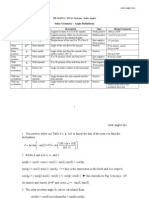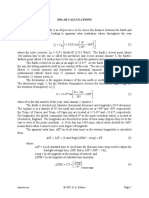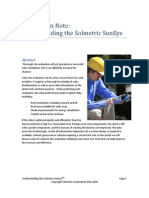FORMULAS (1)
Uploaded by
indrajit jadhavFORMULAS (1)
Uploaded by
indrajit jadhavFORMULAS
SOLAR RADIATION AND ITS MEASURMENTS
(
I n=I sc 1+ 0.033 cos
360 n
365 )
(extra-terrestrial radiation)
n =day of the year counted from the first day of January,
I sc = solar constant, 1367 W/m2 .
Latitude (ϕ) , hr angle (ω), zenith angle (θz ¿ , surface azimuth angle (γ ¿, solar
azimuth angle( γ s),
δ ( in degrees )=23.45 sin
[ 360
365 ]
(284+ n) (declination)
H g/Hc = a+b (DL/Dmax)
n =day of the year counted from the first day of January
cos θ=¿ sin ϕ (sin δ cos β+ cos δ cos γ cos ω sin β)
+cos ϕ ( cos δ cos ω cos β−sin δ cos γ sin β )
+ cos δ sin γ sin ω sin β
θ = the angle between the incident beam and the normal to the
tilted surface.
ϕ = Latitude (in degrees), δ = Declination (in degrees), β = Slope or tilt angle (in degrees),
ω = Hour angle = (12:00 - Solar Time) (in hours) × 15 degrees.
i. For a vertical surface, β=90 ∘. Therefore,
cos θ=sin ϕ cos δ cos γ cos ω−cos ϕ sin δ cos γ +cos δ sin γ sin ω
ii. For a horizontal surface, β=0 ∘. Therefore,
cos θ=sin ϕ sin δ+cos ϕ cos δ cos ω
iii. In this case, the angle θ is the zenith angle θ z
In northern hemisphere the sun during winter is towards south. For a surface south, γ =0∘.
Therefore,
cos θ=¿ sin ϕ (sin δ cos β+ cos δ cos ω sin β)
+cos ϕ (cos δ cos ω cos β−sin δ sin β ) sin δ sin (ϕ−β )+cos δ cos ω cos (ϕ−β )¿
¿
(iv) For a vertical surface facing due south, β=90 ∘ , γ =0∘ . Therefore,
cos θ=sin ϕ cos δ cos ω−cos ϕ sin δ
Local apparent time (LAT) = Standard time ± 4 (Standard time longitude – Longitude of
location) + (Time correction)
/
Beam radiation γ =0∘ ; cos θ=sin δ sin (ϕ−β)+cos δ cos ω cos (ϕ−β)
Rb = sin δ sin ( ϕ−β )+ cos δ cos ω cos (ϕ−β) sin ϕ sin δ+ cos δ cos ω cos ϕ
Solar time = Standard time ± 4 (Lst – Lloc) (min) + E (min)
E = 9.87 sin 2B – 7.53 cos B – 1.5 sin B min.
B = (360/364)(n – 81)
Hg/Ho = a+b ( td/tdmax) (Monthly Average, Daily Global Radiation)
Hg = monthly average of the daily global radiation on a horizontal surface at a location
Ho = monthly average of the daily extraterrestrial radiation which would fall on a horizontal
surface at the same location in absence of atmosphere
dt = monthly average of the sunshine hours per day at a location
dmax t = monthly average of the maximum possible sunshine hours per day at a location
(i.e., day length of the average day of the month)
You might also like
- SolarAngles Radiation Worksheet_TemplateB (1) (1)No ratings yetSolarAngles Radiation Worksheet_TemplateB (1) (1)9 pages
- Lecture 02 Solar Energy Conversion IntroductionNo ratings yetLecture 02 Solar Energy Conversion Introduction37 pages
- 7.1 Solar Radiation On Inclined SurfacesNo ratings yet7.1 Solar Radiation On Inclined Surfaces13 pages
- Solar Calculations: © 2007, K. E. HolbertNo ratings yetSolar Calculations: © 2007, K. E. Holbert7 pages
- Mathematical Modeling: Abstract This Chapter Presents A Detailed Mathematical Analysis of Ptcs. It IsNo ratings yetMathematical Modeling: Abstract This Chapter Presents A Detailed Mathematical Analysis of Ptcs. It Is28 pages
- Solar Radiation Geometry: Between A Line Drawn From A PointNo ratings yetSolar Radiation Geometry: Between A Line Drawn From A Point11 pages
- Lecture 4.1 - Solar Properties (Part-2)No ratings yetLecture 4.1 - Solar Properties (Part-2)23 pages
- Smart Techniques For Optimizing Tilt Angles of Solar PanelsNo ratings yetSmart Techniques For Optimizing Tilt Angles of Solar Panels4 pages
- Lecture 3.1 - Solar Properties (Part 1)No ratings yetLecture 3.1 - Solar Properties (Part 1)30 pages
- EN301 - Tutorial SOlar Radiation EstimationsNo ratings yetEN301 - Tutorial SOlar Radiation Estimations18 pages
- SUE4801_ASSESSMENT 2_MEMO_2022_240508_190159 (2)No ratings yetSUE4801_ASSESSMENT 2_MEMO_2022_240508_190159 (2)3 pages
- Formulas for Solar Angle of Incidence - object on earthNo ratings yetFormulas for Solar Angle of Incidence - object on earth1 page
- CONICAL EQUAL-AREA PROJN. With II SP Partha Das - ABNSCNo ratings yetCONICAL EQUAL-AREA PROJN. With II SP Partha Das - ABNSC7 pages
- 07-Solar Resource Part 2: ECEGR 452 Renewable Energy SystemsNo ratings yet07-Solar Resource Part 2: ECEGR 452 Renewable Energy Systems57 pages
- Fundamental of Solar Energy: Lecture Reference Naveed Ur RehmanNo ratings yetFundamental of Solar Energy: Lecture Reference Naveed Ur Rehman25 pages
- Solar Angles:: Ruya Isam 2019 4 Fuel and EnergyNo ratings yetSolar Angles:: Ruya Isam 2019 4 Fuel and Energy7 pages
- Time, Coordinate Systems and Spherical Astronomy: IWAA 2018No ratings yetTime, Coordinate Systems and Spherical Astronomy: IWAA 201833 pages
- Trigonometric Ratios to Transformations (Trigonometry) Mathematics E-Book For Public ExamsFrom EverandTrigonometric Ratios to Transformations (Trigonometry) Mathematics E-Book For Public Exams5/5 (1)
- De Moiver's Theorem (Trigonometry) Mathematics Question BankFrom EverandDe Moiver's Theorem (Trigonometry) Mathematics Question BankNo ratings yet
- Updated Acad - Cal - 2024 - 25 - Updated - 27 - June - 2024No ratings yetUpdated Acad - Cal - 2024 - 25 - Updated - 27 - June - 20247 pages
- Welcome Letter and Important InstructionsNo ratings yetWelcome Letter and Important Instructions11 pages
- GeWiS Solar Presentation IR Rev02 19092017 PDFNo ratings yetGeWiS Solar Presentation IR Rev02 19092017 PDF48 pages
- GR 11 Relab Notes and Activities CompressedNo ratings yetGR 11 Relab Notes and Activities Compressed124 pages
- Cambridge High School: Subject-Geography Resource Sheet of Insolation Class - 9 (A & B)100% (1)Cambridge High School: Subject-Geography Resource Sheet of Insolation Class - 9 (A & B)4 pages
- Smart Agriculture System Poweredby Solar EnergyNo ratings yetSmart Agriculture System Poweredby Solar Energy67 pages
- Energies: Effect of Soiling On Solar Photovoltaic Performance Under Desert Climatic ConditionsNo ratings yetEnergies: Effect of Soiling On Solar Photovoltaic Performance Under Desert Climatic Conditions18 pages
- Study Global Solar Radiation Based On Sunshine Hours in IraqNo ratings yetStudy Global Solar Radiation Based On Sunshine Hours in Iraq11 pages
- Solar Energy Reaching The Earth's SurfaceNo ratings yetSolar Energy Reaching The Earth's Surface7 pages
- 2017 Climate Change Multiple Choice QuestionsNo ratings yet2017 Climate Change Multiple Choice Questions7 pages
- [Ebooks PDF] download Elementary Climate Physics 1st Edition F. W. Taylor full chapters100% (7)[Ebooks PDF] download Elementary Climate Physics 1st Edition F. W. Taylor full chapters71 pages
- Article Assessment - Feasibility of Solar EnergyNo ratings yetArticle Assessment - Feasibility of Solar Energy7 pages
- Site Adaptation and Solar Radiation Forecasting1No ratings yetSite Adaptation and Solar Radiation Forecasting114 pages
- Dynamic Thermal Rating of Power Transmission Lines Related To Renewable ResourcesNo ratings yetDynamic Thermal Rating of Power Transmission Lines Related To Renewable Resources16 pages
- Daylight Booklet 3 Nov 2017 Med Single PagesNo ratings yetDaylight Booklet 3 Nov 2017 Med Single Pages48 pages
- Pseudo Bond Graphs of Circulating Fluids With Application To Solar Heating DesignNo ratings yetPseudo Bond Graphs of Circulating Fluids With Application To Solar Heating Design16 pages
- Solar Energy Potential and Applications in MyanmarNo ratings yetSolar Energy Potential and Applications in Myanmar4 pages

































































































